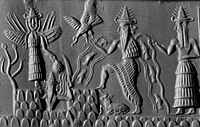Mušḫuššu
 | |
| Grouping | Mythological hybrid |
|---|---|
| Folklore | Babylonian mythology |
| Other name(s) | Sirrush |
| Region | Mesopotamia |

The mušḫuššu (𒈲𒍽; formerly also read as sirrušu or sirrush) or mushkhushshu (Akkadian pronunciation: [muʃˈχuʃ.ʃum]) is a creature from ancient Mesopotamian mythology. A mythological hybrid, it is a scaly animal with hind legs resembling the talons of an eagle, lion-like forelimbs, a long neck and tail, two horns on its head, a snake-like tongue, and a crest. The mušḫuššu most famously appears on the Ishtar Gate of the city of Babylon, dating to the sixth century BCE.
The form mušḫuššu is the Akkadian nominative of Sumerian: 𒈲𒍽 MUŠ.ḪUŠ, 'reddish snake', sometimes also translated as 'fierce snake'.[2] One author,[3] possibly following others, translates it as 'splendour serpent' (𒈲 MUŠ is the Sumerian term for 'serpent'). The older reading sir-ruššu is due to a mistransliteration of the cuneiform in early Assyriology[4] and was often used as a placeholder before the actual reading was discovered.[5]
History
[edit]Mušḫuššu already appears in Sumerian religion and art, as in the "Libation vase of Gudea", dedicated to Ningishzida by the Sumerian ruler Gudea (21st century BCE short chronology).[1][6]
The mušḫuššu was the sacred animal of Marduk and his son Nabu during the Neo-Babylonian Empire. The dragon Mušḫuššu, whom Marduk once vanquished, became his symbolic animal and servant.[7] It was taken over by Marduk from Tishpak, the local god of Eshnunna.[8]
The constellation Hydra was known in Babylonian astronomical texts as Bašmu, 'the Serpent' (𒀯𒈲, MUL.dMUŠ). It was depicted as having the torso of a fish, the tail of a snake, the forepaws of a lion, the hind legs of an eagle, wings, and a head comparable to the mušḫuššu.[9][10]
-
9th century BCE depiction of the Statue of Marduk, with his servant dragon Mušḫuššu at his feet. This was Marduk's main cult image in Babylon.
-
Head of dragon dating from the Neo-Babylonian Empire (626 BCE – 539 BCE) from the Louvre Museum's collection
See also
[edit]References
[edit]- ^ a b Wiggermann, F. A. M. (1992). Mesopotamian Protective Spirits: The Ritual Texts. Brill Publishers. p. 156. ISBN 978-90-72371-52-2.
- ^ "The Electronic Text Corpus of Sumerian Literature". The ETCSL project, Faculty of Oriental Studies, University of Oxford. 2006-12-19. Retrieved 2014-08-25.
- ^ Costello, Peter (1974). In Search of Lake Monsters. Coward, McCann & Geoghegan. ISBN 9780698106130 – via Internet Archive.
- ^ Oppenheim, A. Leo; Reiner, Erica, eds. (1977). The Assyrian Dictionary of the Oriental Institute of the University of Chicago (PDF). Vol. 10: M, Part II. Chicago, IL: University of Chicago Oriental Institute. p. 270. ISBN 0-918986-16-8.
- ^ Ceram, C. W. (1967). Gods, Graves, and Scholars: The Story of Archaeology. Translated by Garside, E. B.; Wilkins, Sophie (2nd ed.). New York: Alfred A. Knopf. p. 294.
- ^ Wiggermann, F. A. M. (1992). Mesopotamian Protective Spirits: The Ritual Texts. Brill Publishers. p. 168. ISBN 978-90-72371-52-2.
- ^ Wiggermann, F. A. M. (1992). Mesopotamian Protective Spirits: The Ritual Texts. Brill Publishers. p. 157. ISBN 978-90-72371-52-2.
- ^ Bienkowski, Piotr; Millard, Alan Ralph (2000). Dictionary of the Ancient Near East. University of Pennsylvania Press. p. 189. ISBN 978-0-8122-3557-9.
- ^ Wiggerman, F. A. M. (1 January 1997). "Transtigridian Snake Gods". In Finkel, I. L.; Geller, M. J. (eds.). Sumerian Gods and their Representations. Cuneiform Monographs. Vol. 7. Groningen, Netherlands: Styx Publications. pp. 34–35. ISBN 978-90-56-93005-9.
- ^ E. Weidner, Gestirn-Darstellungen auf Babylonischen Tontafeln (1967) Plates IX–X.
Notes
[edit]- 1.^ Similar to the Set animal in Egyptian mythology and the Qilin in Chinese mythology.




